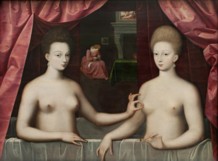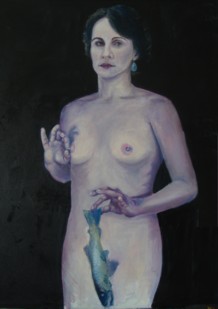

Gabrielle Without Her Sister
I saw the painting “Gabrielle d’Estrées et une de ses soeurs,” by an unknown artist, painted c.1594, for the first time at the Louvre in May 2012. Gabrielle is taking a bath, accompanied by her sister, who is lightly pinching Gabrielle’s right breast. It is such an odd scene that one is simultaneously stimulated and repulsed. The crowd of men blocking my view assured me that I was not alone with my first impulse. The feeling of discomfort, however, was the one that captivated me the most. It seemed invasive and looked painful. It was contradictory that one woman, a sister no less, would treat another woman’s breast with seeming contempt. Gabrielle’s left hand finally caught my attention, which, I discovered later, holds the coronation ring of King Henri IV of France – a token of his love. The plot thickens when one realizes that Henri IV applied to Pope Clement VIII for an annulment of his marriage to Queen Margaret of France, in an attempt to marry Gabrielle, who was pregnant. This was to be her fourth child with Henri IV. The drama plays out when Gabrielle suddenly gave birth to a stillborn son and died the next day, presumably from poisoning.
I was unable to get the image of Gabrielle out of my mind and knew I would start a painting of her as soon as I returned to my studio. I wanted to focus on Gabrielle and decided to edit out her sister. It was a challenge for my model to pinch her own breast, as it is not a natural position. This is as far as I got with the composition, although I knew I wanted to explore the archetypal content more deeply. Consequently, I was forced to wait for inspiration from my dreams and active imagination. I later resorted to the tarot.
I asked the tarot for guidance and picked a card with the intention of finding the deeper significance of the image of Gabrielle. The card that came up was the King of Cups. This card depicts the King sitting calmly on his throne. The throne sits on top of a turbulent sea. In the background is a fish jumping wildly from the tumultuous ocean. A ship sails steadily on the choppy ocean. These are signs that the unconscious has been allowed to break through and are recognized by the King. He wears a necklace with a fish amulet representing the balance of the unconscious with the conscious. The King is not overwhelmed by the impulses of the unconscious and does not repress his emotions because he has learned to deal with them in a balanced manner. For me, the unconscious has always been depicted as the feminine. She dwells in the domain of spirit. She shows up in my paintings as the Unknown Woman. She is Sophia, the voice of wisdom, and the archetype of the Great Mother, as the goddess of personal and divine love.
The sister pinches the nipple to indicate that Gabrielle is pregnant. The breast symbolizes the life giving source from the Indo-European word ‘bhreus,’ to swell or to sprout, and is linked to the sea as the Source of Life.(1) The breasts naturally connote a sense of twoness. However, they also contain a certain polarity of opposites or a yin/yang element. The Egyptian hieroglyph for breast means breast and moon (feminine).(2) The circular area surrounding the nipple is the ‘areola’ an extension of the Latin ‘aureas’ meaning “golden.”(3) Gold is associated with the sun (masculine). Mythologically, there is a good breast and a bad breast; the breast that supplies and the breast that withholds. The right breast is the masculine breast, related to sun and consciousness. The left breast is feminine, related to the moon and the unconscious. On the other hand, their sameness links the opposites as a way of getting from the physical to the metaphysical, from the known to the unknown.
Gabrielle, in Gabrielle Without Her Sister, pinches her own right breast; the masculine breast of the known material world, dominated by mind-brain consciousness. This represents the ego-based view of the world of patriarchal dominance. Yet, like her sister, she is drawing our attention to the fact that she is pregnant. This connects the breast to the womb. In this way, the painting takes our attention to the pregnant womb where a fish guards the entrance.
The fish represent the dual fish of the Age of Pisces, an age of darkness, in which one fish swims towards the unconscious and the other towards the physical. We have now entered the Age of Aquarius where the emphasis is on the upward swimming fish. However, in the painting, the upward swimming fish is not visible to us because it is gestating inside the womb of the Great Mother. The idea of pinching the right breast, the masculine breast, tells us that the patriarchal is giving way to a higher consciousness, which is transforming in the womb.
It is the transformative nature of the womb, as the ovoid alembic, the spagyric uterus, where we learn to unite the opposites and know our fully realized potential. The Egyptian image of Aquarius is the goddess of the Nile pouring forth the water of life from two vases. She is the vital spiritual power that renews and nourishes all things. Aquarius is about freedom of thought, particularly the freedom that comes with transcending our worldly limitations and harnessing the power of individuality into the service of the greater whole. The visible fish in the painting provides a clue in that it retains an open eye. Jung described the eye of the outer fish as symbolizing a still unrealized archetype of the Self that comprehends spirituality and matter in a single mercurial nature.(4)
The god of the sea, the ocean of the unconscious, is Neptune. Neptune is famous for throwing storm clouds and nets of entanglement over his victims in order to confuse them, blind them, and make them lose their way.(5) Jung warned that in order to be fully manifest in the world is a long and perilous night-sea journey like that of Jonah in the belly of the whale, requiring heroic measures to retrieve the ‘treasure’ therein and re-emerge transformed.(6) Our release from Neptune’s net is symbolized by the dual fish archetype, where one fish tunes into its inner vision and is guided by heart-consciousness and the Cosmic Ocean within. The other is “lost at sea,” driven to the addiction of technology, power, and greed.
Gabrielle Without Her Sister also reveals a hint of the transformative nature of the feminine as she contains mermaid-like features below her waist. The mermaid embodies the spirit of the unconscious. She descended from the whale that once held Jonah, inside which great mysteries were revealed to him.(7) The dual nature of the mermaid, like the breasts, lures us to destruction or carries us to her watery domain of the unconscious.
The painting, like poetry, speaks to us metaphorically through the language of symbols that arise from the unconscious; through the language understood by the King of Cups.
1. etymonline.com/index.php?term=breast
2. The Egyptian hieroglyph, mena, means both "moon" and "breast." Hathor, the sky goddess, is the celestial cow, and is depicted as carrying the moon disk between her horns. From her breasts flow the stars and Milky Way. (http://www.realmagick.com/egyptian-hieroglyph)
3. The Book of Symbols, Reflections on Archetypal Images, (Taschen) p. 388
4. Jung C G, CW 9ii:103ff
5. Guttman A, Johnson K, Mythic Astrology, Archetypal Powers in the Horoscope, (Llewellyn Publications, 1993) p. 358
6. Jung C G, CW 5:509-10
7. Jung C G, CW 13:180
.
